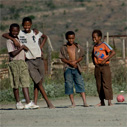Camera in hand, I follow Hailey through the roads of Glenmore as the Sunday afternoon beats down on us. She, in turn, is following Ben Mafane, the township patriarch whose athletic frame understates his age. It’s easy to understand why he is dubbed the ‘Mandela of Glenmore’, having been a former boxer who now teaches the sport to many of the local youths. Some of them are with us, forming his entourage as we go from house to house.
Hailey interviews a teacher here, the owner of the community creche there. For my part, I chase laughing children down a side street as they pose with daft expressions in the hot dust. Then laugh madly at their faces on the back screen afterwards.
Human Rights Day is coming soon to South Africa. It was a fact that our lecturer thought would make a good motivation to get us to try our hand at being real journalists. Instead of the sort who interview our friends for inane opinions on the world and write it as though it was news. So we went to find stories about human rights. Which is how I happened to end up in Glenmore. Hailey knew a guy who knew a guy who… and so on… who knew about Glenmore. Created on the edge of the former Ciskei homeland by misguided white folk with an obsession for forcibly removing people, Glenmore sits almost an hour’s drive from Grahamstown, which is itself in a wide orbit away from any city worth the name.
The town is a baking mix of small government houses in various states of repair and shades of entertaining colour, tin shacks, an occasional car from another era, heat and dust. The original inhabitants came here from Grahamstown, Port Elizabeth and a couple of other major centers back in the late seventies as far as I have been following Hailey’s conversation with Ben. She has all the notes – kept on a furiously scribbled pad of notepaper, rapidly growing stiff in the sun. I am just the photographer and chaser of children, plus the occasional goat.
From what I can tell, the early years here were particularly difficult, with a tornado wiping out houses and killing over a hundred people in the first months of settlement. As a result, the town was resettled perhaps a kilometer away from the original site, where it has sat in the summer heat and winter cold for decades since. Ben Mafane, pointing and proclaiming as we walk, is older than any story here. He was the reason we originally came, having been in the news some years ago for throwing rocks through the court offices in protest at his community having no work or basic facilities. His own way of getting a neglectful state to notice this place once more. He narrowly avoided jail for his efforts, which is more impressive when – according to his account – he went back twice more over the years, rocks in hand, to make his point when he had no other way to get it across.
Glenmore has since received schools, a church and the occasional helping hand from a benevolent corporate. Ben explains that Vodacom will soon be donating computers to one of the schools here. I wonder how on earth corporations even knew here existed.
The school, when we reach it, is littered with young goats who eye us with lazy interest. Hailey and Ben are talking about the buildings somewhere behind me and I wonder if she will ask him where the computers will go, and who will teach the learners how to use them. I’d like to think that clever minds have foreseen this question and made appropriate plans. Yet between playgrounds of goats and bare classrooms, I realise that it may be faith misplaced.
Further on, near the point that Glenmore slips away into scrubby hills, children are playing football in the street. Smokey grey dust kicks up as the ball leaps and runs through a dozen kicking legs. It’s stuffed red plastic outline is hard to miss, though I can’t help but admire the goalie’s willingness to dive over the gravel time and again to grab a hold of it before both of them risk being kicked backward through the tin can goalposts. I feel sore just watching him doing it.
[kml_flashembed allowfullscreen=”true” publishmethod=”dynamic” fversion=”8.0.0″ movie=”http://www.richardstupart.com/images/sets/football/loader.swf” base=”.” width=”542″ height=”441″ targetclass=”flashmovie”]
[/kml_flashembed]
It’s much later and many meetings and stories have passed before Hailey and I make our way back to Grahamstown. We leave behind a soccer coach, a school teacher, three rappers who have promised to call me when they next have a gig in the area, an old lady with the largest smoking pipe I have ever seen, and goats. At least a few hundred goats. Ahead is a return to comfortable lives that couldn’t be more different to a day in Glenmore if we were astronauts.
Behind are fistfuls of fascinating stories whose owners have only given us the smallest glimpses. There isn’t one story in Glenmore. No economic narrative, tale of the South African dream deferred or colourful embellishment would ever really capture the nature of the place. It is what it is. It has Ben Mafane. Kids that love football and posing for the camera. And goats whose antics fascinate me. They are stories all. Fascinating little fragments that Hailey and I are only beginning to learn to bring back to a world that has never seen them.




